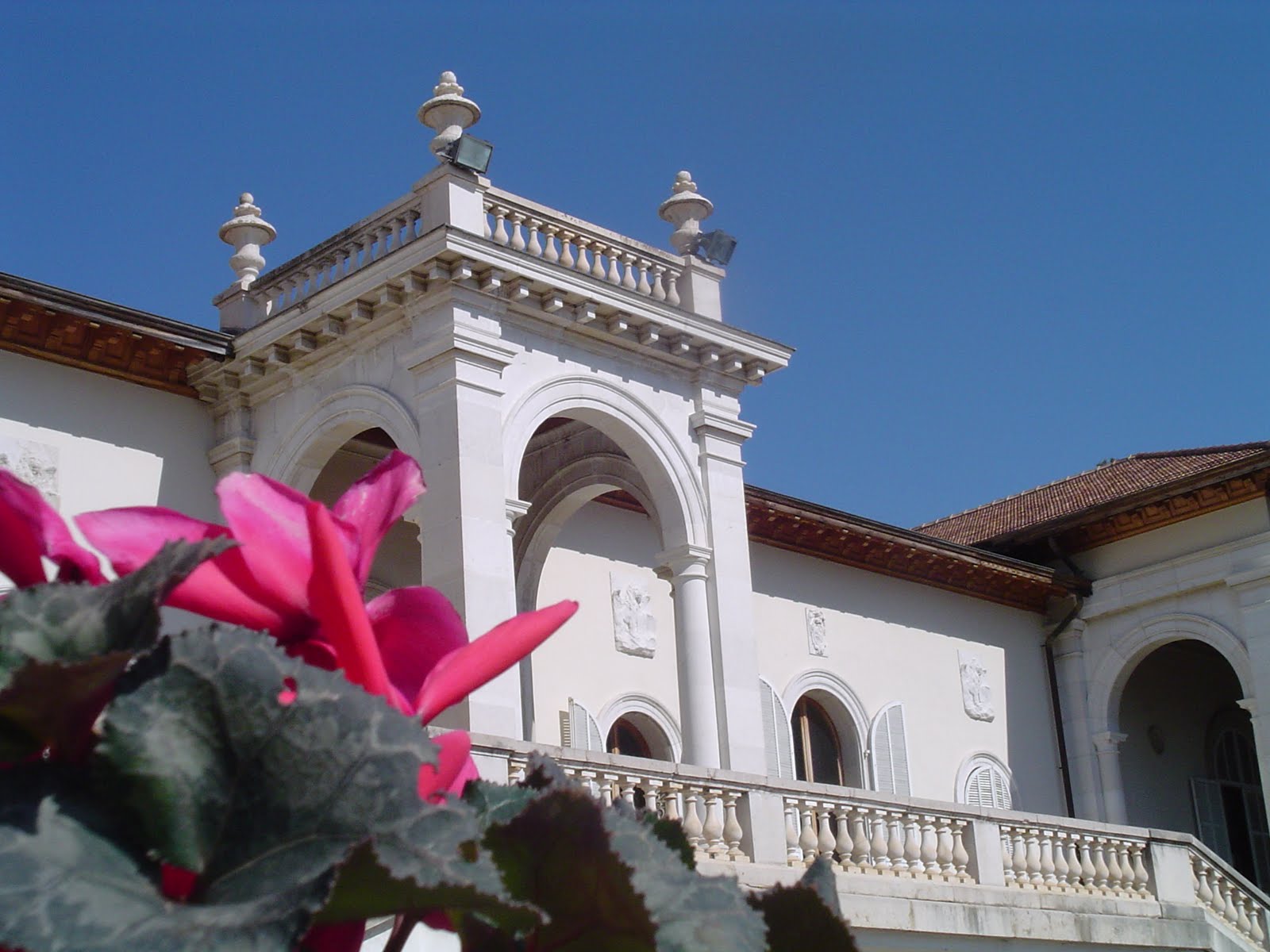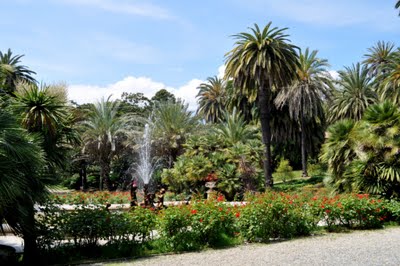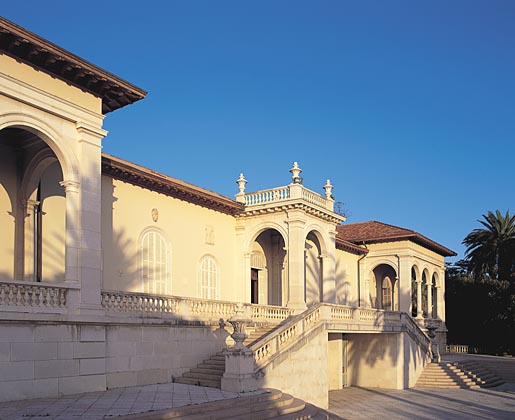
Villa Ormond
This post is also available in:
 Italiano (Italian)
Italiano (Italian)
East of Sanremo visitors can enjoy the park of Villa Ormond, rich in exotic and rare plants. Starting from Piazza Colombo, take the tree-lined Corso Garibaldi, go past Villa Zirio, the town hall and eventually get to the villa on Corso Cavallotti.
The modern very busy road has divided the original park in two parts. In the past, this estate descended to the sea from the top of the hill where the villa was built. The latter was a property of Dr. Ormond, but it had been previously owned by the Rambaldi family.
The villa and the park were designed by those ancient owners with the help of the Swiss architect Amile Réverdin, at the end of the XIX century.
TODAY
Today, Ormond garden is a vast public facility that represents a true green oasis; rich in exotic vegetation, its main architectural element is the ancient stone fountain with “putti” cherubs.
The villa has been recently restored to its former glory, thanks to the hard work of the Municipality of Sanremo. The building is surrounded by a large terrace with two Renaissance-like loggias and an elegant portico before the main entrance. Inside the building, there are several large polychrome coffered ceilings and a fireplace from the Doria di Dolceacqua’s castle, inside a lounge.
Today, one wing of the villa houses the International Institute of Humanitarian Laws, while it is often the venue for international floral exhibitions or for tourist events. In recent times, the Municipality of Sanremo has spent considerable amounts of money to restore the whole building to its former glory.
The villa has been cleaned up, the spaces in the green area have been redesigned, and overall illumination has been improved in order to emphasize the wealth of vegetation on the estate.
THE GARDENS
The gardens of Villa Ormond in Sanremo have a “room-like” layout, with themed plant environments.
There is a palm grove, and the ficus area, while the central part features a typical Italian garden.
There is also a “Japanese Garden”, born from the true friendship between the city of Sanremo and the city of Atami. This very part of the estate offers a deep-green turf, decorating boulders, and stones, exotic species of plants, along with a typically oriental atmosphere. The ZEN philosophy area, where beauty in its simplicity is dramatically prominent, is particularly beautiful. The typical original flora of the eastern part of the world perfectly integrates with the local one. The main species included in the Japanese Garden are Bambusa vulgaris, Bambusa arundinacea “Aurea”, Corylus avellana “Contorta”, Bambusa arundinacea “Aurea”, Pinus parviflora “Pentaphylla”, Chamaecyparis “pisifera Filifera Aurea”, Cryptomeria japonica “Globosa”, Acer palmatum, Corylopsis pauciflora, Cornus kousa, Ilex crenata, Cydonia japonica, Mahonia iaponica, Styphnolobium japonicum, Lagerstroemia indica, Chamaecyparis obtusa “Nana”, and Nandina domestica.
The most significant plants in the rest of the garden are grouped in the wondrous “Palmetum”. There, visitors can see two groups of reclining Phoenix, of considerable size, some date palms (Phoenix dactylifera) already mentioned in the Napoleonic land register, and a magnificent Erythrina crista-galli excel. – with an enchanting blood-red bloom. There are also some Jacaranda mimosifolia, camphor trees (Cinnamomum camphora), large Ficus macrophylla, some Corynocarpus laevigatus, palms (Phoenix dactylifera, Washingtonia filifera, Washingtonia robusta), Caesalpinia gilliesii, Trithrinax campestris, and specimens of Nolina longifolia.
Since 2017, this garden has been the very first “home of Floriculture”, therefore the world-acclaimed flower cultivation of Sanremo has finally got its own headquarters.
In the park of Villa Ormond there is also a museum about the most important times in the history of the city. This facility is set inside the Winter building (“Palazzina Winter”), in the heart of a green area, and a few steps from the sea. This very structure took thirteen years to be thoroughly restored.
The very first Italian flower museum thus tells the story of the local Moro family, who created many rose and carnation hybrids, while being part of a major boost to the local flower economy and centuries-old traditions.
More than one hundred years of Sanremo’s floriculture are told in the rooms of the Winter building, from the first certified patents to the ancient tools used in the countryside, and from greenhouses to small labs used for developing hybrid species. Furthermore, there is a comprehensive exhibition of the poisonous substances used to get rid of parasites and clean woven baskets, watering cans, and shoulder pumps. Another interesting display shows canes and hemp threads used to support carnations.
“We have collected thousands of finds to build a journey through multimedia and photographic panels in a historic location; a true sanctuary where symbolic pilgrimages can rediscover a very important historical period of our country”, has recently stated the Municipality gardens manager, Claudio Littardi, also president of the Center for studies and research of palm trees.
On display, there are even many original photos of “fairytale-like” weddings: that of Elizabeth II with Philip of Edinburgh, on 20 November 1947, four years and three months before the future queen ascent to the throne, and that between the Hollywood stars Linda Christian and Tyrone Power, celebrated in Rome on January 28, 1949. On both occasions, magnificent white carnations from Sanremo were used.
“It’s a dream come true. Our aim was simply to explain to citizens, but above all to tourists, why Sanremo is known worldwide as the city of flowers”, said mayor Alberto Biancheri, grown amongst local gardens, during the inauguration of the Museum; he is also the owner of an important buttercup hybridization company launched in 2004. It actually took three municipal administrations and two prefectural commissioners to eventually get the ribbon cut ceremony. The councilor of Liguria Region, Alessandro Piana, then added: “We will make sure to shorten any further bureaucratic delays, like the ones which hampered our project for Villa Ormond”.
Easter Monday 2004 was dedicated to a competition of “floral designers”, who created their masterpieces for the famous Sanremo Festival; then, refreshments were served in the park, and an Argentinian tango show was offered in Villa Ormond’s hall. It all happened at a stone’s throw from the flowerbed dedicated to Libereso Guglielmi, the internationally acclaimed botanist, who had recently passed away – he was known as the “Calvino” gardener. He actually inspired the idea of “rampant baron” to novelist Italo Calvino and spoke about his love for Sanremo’s flowers in many books. True masterpieces of Mother Nature, to admire and also to eat.
Discovering the beauties of the Riviera can also happen in bright sunlight, through outdoor paths dedicated to the real pioneers of floriculture. Guided walks were made available, especially during the so-called “Jardival”, the Flower and Garden Festival of Sanremo.
This post is also available in:
 Italiano (Italian)
Italiano (Italian)
Contatti
Corso Cavallotti 111/113 - Sanremo(IM)
0184 541848
Altre info
Libero
autunno inverno tutti i giorni dalle 8.00 alle 18.00; primavera estate tutti i giorni dalle 7.00 alle 20.30





